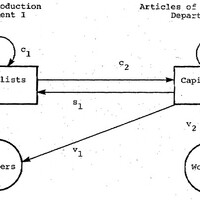Commodity Flows in the Two-Department Model of Simple Reproduction
Item
-
Title
-
Commodity Flows in the Two-Department Model of Simple Reproduction
-
Description
-
The actors in the diagram are the collective capitalists and workers in the departments. Each arrow represents a commodity exchange (more properly, a class of exchanges) and is labeled with the value of commodities exchanged. The direction of the arrow represents the direction of the exchange: from seller to buyer. Money (of equal value) flows in the opposite direction. Thus, for example, the arrow from workers in Department I to capitalists in the same department represents the sale of these workers' labor-power to their employers. As a consequence of this transaction, capitalists in Department I acquire labor-power of value v1, and workers in Department I receive value v1 in the form of money, that is, wages. With their wages, workers in Department I purchase consumption goods of value v1 from capitalists in Department II; this exchange is shown as the arrow from capitalists II to workers I. Capitalists and workers in both departments purchase their consumption goods from the capitalists of Department II. Capitalists in both departments buy their means of production from the capitalists of Department I. Workers in each department sell their labor-power to the capitalists of the same department.
A word should be said about the arrow from capitalists in Department I to themselves: at first glance this relation seems paradoxical, until we recall that capitalists producing new means of production themselves employ means of production, which must be bought from other capitalists in their department. (In certain special circumstances capitalists may in fact employ part of their own product to furnish new means of production -e.g., seed in agriculture -- but these are exceptional cases.) A similar comment applies to the self-directed arrow for capitalists in Department II: they purchase articles of consumption from each other.
-
Designer
-
Fox, John
-
Date
-
1985
-
Source
-
Understanding Capital Volume II
-
Bibliographic Citation
-
John Fox, 1985. Understanding Capital Volume II. Progress Books. Figure 7
 Fox-Capital 7.jpg
Fox-Capital 7.jpg